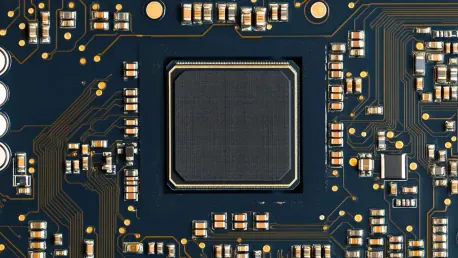Micron Technology (NASDAQ: MU) has long been a key player in the semiconductor industry, particularly known for its innovative memory and storage solutions. However, over the past year, the company’s stock has faced significant volatility, leading many investors to question its future performance. As the Artificial Intelligence (AI) boom continues to drive demand for advanced semiconductor technologies, experts are predicting a potential turnaround for Micron in 2025. This article delves into the factors influencing Micron’s stock performance and explores the potential for growth in the coming years.
Current Semiconductor Stock Performance
Driven by advancements in Artificial Intelligence (AI), the semiconductor industry has experienced substantial growth. Prominent companies like Nvidia, Taiwan Semiconductor Manufacturing, and Broadcom have led the charge, enjoying notable stock price increases. Specifically, the VanEck Semiconductor ETF, which tracks the performance of the semiconductor sector, reported an impressive 39% increase in 2024. This performance outpaced both the S&P 500 and the Nasdaq Composite indexes, underscoring the robust demand within the semiconductor industry.
Despite the overall positive trend, Micron Technology has struggled to keep pace with its peers. In 2024, Micron’s stock saw only a modest rise of 6%, starkly contrasting the significant gains achieved by other leading semiconductor firms. This disparity has raised concerns among investors and analysts alike regarding Micron’s ability to capitalize on the AI-driven growth within the sector. The company’s perceived underperformance relative to its peers highlights the challenges Micron faces in meeting the heightened expectations tied to the broader semiconductor market dynamics.
Micron Technology’s Struggles
Micron’s stock volatility has been a significant concern for investors, with the company’s shares experiencing a substantial drop of 38% since June. This decline underscores the heightened market apprehension surrounding Micron’s short-term performance and long-term potential. Much of this volatility can be attributed to unmet investor expectations and short-term projections that have yet to materialize. The fluctuation in Micron’s stock price reveals the fragile sentiment among investors, driven largely by external comparisons and sector-wide performance benchmarks.
One of the primary reasons behind Micron’s struggles is the prevalent practice of comparing it with other high-profile semiconductor companies. Investors often expect uniform performance across the sector, neglecting the unique opportunities and challenges each company faces. Micron’s specialization in memory and storage solutions sets it apart from other firms producing GPUs or networking infrastructure components. This fundamental difference in product lines can lead to distinct market dynamics that impact Micron differently than its peers. Consequently, Micron’s stock has encountered increased pressure due to investor comparisons that do not account for its specific market focus.
Factors Influencing Micron’s Volatility
The volatility in Micron’s stock can be closely linked to the market’s overreaction to short-term disappointments. Investors have displayed a tendency to react swiftly to any negative news, leading to notable fluctuations in Micron’s stock price. This reaction is frequently driven by comparisons with other semiconductor firms that have outperformed Micron, creating unrealistic expectations for the company’s performance. Consequently, Micron’s stock has experienced heightened sensitivity to news and market sentiment, contributing to its observed volatility.
Another significant factor contributing to Micron’s stock volatility is the company’s core focus on memory and storage solutions. While these products are crucial for AI applications, they do not generate the same level of excitement as GPUs or other high-profile semiconductor technologies. This perceived discrepancy has led many investors to overlook the essential role that memory and storage solutions play in the AI infrastructure ecosystem. As a result, there is a lingering perception that Micron is not as well-positioned to capitalize on the AI boom, despite its critical contributions to enabling advanced AI functionalities through its specialized product offerings.
Potential for Recovery in 2025
Despite the recent volatility, there is a growing consensus that Micron’s downturn may be an overreaction by the market. Experts argue that the company’s stock is poised for a significant recovery in 2025, driven by the increasing demand for AI infrastructure. As AI applications become more sophisticated, the need for advanced memory and storage solutions will continue to grow, benefiting companies like Micron. This anticipated surge in AI-related investments presents a promising opportunity for Micron to capitalize on its essential role within the semiconductor landscape.
Micron’s fiscal first quarter of 2025 has already shown promising signs of recovery, with the company reporting a 400% year-over-year increase in data center revenue. This substantial growth in data center operations underscores the rising significance of Micron’s advanced memory chips in powering AI applications. The impressive revenue gains highlight Micron’s potential to meet the growing demands of the AI market and capitalize on the expanding need for high-performance computing capabilities. Such positive indicators suggest that Micron is well-positioned to benefit from the increasing investments in AI infrastructure, driving its recovery and long-term growth potential.
Growth in Data Center Operations
The surge in data center revenue serves as a testament to Micron’s ability to meet the expanding demands of AI infrastructure. As AI applications necessitate more processing power and storage capacity, data centers are becoming increasingly reliant on advanced memory solutions. Micron’s products are well-suited to fulfill these needs, positioning the company for future growth. This trend underscores the essential role that Micron’s memory and storage solutions play in enabling the seamless operation of AI-driven systems, further solidifying its market position.
Management’s projections further support the optimistic outlook for Micron, with the company estimating that the total addressable market for high bandwidth memory will reach $100 billion by 2030. This significant growth potential highlights the escalating demands of AI and data center operations, aligning with Micron’s core focus areas. The company’s strategic emphasis on developing high-performance memory solutions positions it favorably to capture a substantial portion of the expanding market. These projections underscore the long-term opportunities available to Micron, driven by the sustained growth in AI applications and related infrastructure investments.
Market Projections and Long-Term Outlook
Micron Technology (NASDAQ: MU) has been a significant force in the semiconductor sector, particularly recognized for its cutting-edge memory and storage solutions. Despite its strong industry presence, the company’s stock has experienced considerable volatility over the past year, causing many investors to question its future prospects. The ongoing surge in Artificial Intelligence (AI) is driving demand for sophisticated semiconductor technologies, leading experts to forecast a potential recovery for Micron in 2025. This article explores the various factors impacting Micron’s stock performance, such as market conditions, technological advancements, and competitive pressures. Additionally, we examine the company’s strategic initiatives and potential for growth in the coming years, particularly within the expanding AI market. As Micron continues to innovate and adapt, the potential for a significant stock rebound appears increasingly plausible, offering a hopeful outlook for both the company and its investors.









